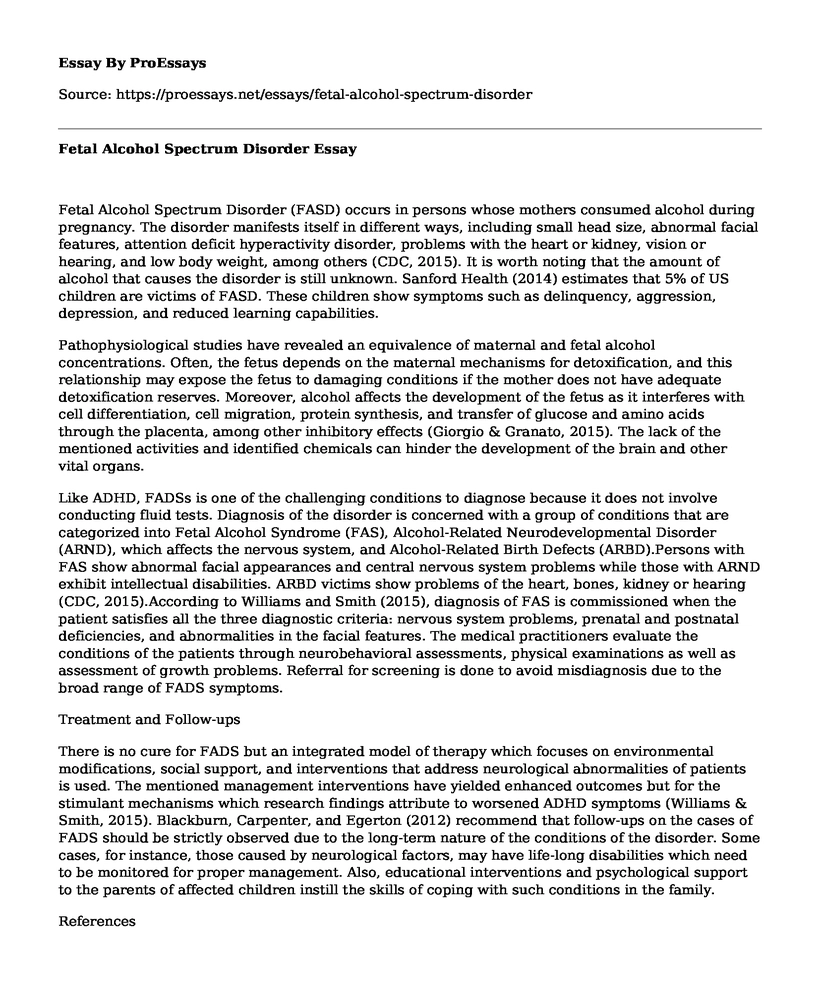Fetal Alcohol Spectrum Disorder (FASD) occurs in persons whose mothers consumed alcohol during pregnancy. The disorder manifests itself in different ways, including small head size, abnormal facial features, attention deficit hyperactivity disorder, problems with the heart or kidney, vision or hearing, and low body weight, among others (CDC, 2015). It is worth noting that the amount of alcohol that causes the disorder is still unknown. Sanford Health (2014) estimates that 5% of US children are victims of FASD. These children show symptoms such as delinquency, aggression, depression, and reduced learning capabilities.
Pathophysiological studies have revealed an equivalence of maternal and fetal alcohol concentrations. Often, the fetus depends on the maternal mechanisms for detoxification, and this relationship may expose the fetus to damaging conditions if the mother does not have adequate detoxification reserves. Moreover, alcohol affects the development of the fetus as it interferes with cell differentiation, cell migration, protein synthesis, and transfer of glucose and amino acids through the placenta, among other inhibitory effects (Giorgio & Granato, 2015). The lack of the mentioned activities and identified chemicals can hinder the development of the brain and other vital organs.
Like ADHD, FADSs is one of the challenging conditions to diagnose because it does not involve conducting fluid tests. Diagnosis of the disorder is concerned with a group of conditions that are categorized into Fetal Alcohol Syndrome (FAS), Alcohol-Related Neurodevelopmental Disorder (ARND), which affects the nervous system, and Alcohol-Related Birth Defects (ARBD).Persons with FAS show abnormal facial appearances and central nervous system problems while those with ARND exhibit intellectual disabilities. ARBD victims show problems of the heart, bones, kidney or hearing (CDC, 2015).According to Williams and Smith (2015), diagnosis of FAS is commissioned when the patient satisfies all the three diagnostic criteria: nervous system problems, prenatal and postnatal deficiencies, and abnormalities in the facial features. The medical practitioners evaluate the conditions of the patients through neurobehavioral assessments, physical examinations as well as assessment of growth problems. Referral for screening is done to avoid misdiagnosis due to the broad range of FADS symptoms.
Treatment and Follow-ups
There is no cure for FADS but an integrated model of therapy which focuses on environmental modifications, social support, and interventions that address neurological abnormalities of patients is used. The mentioned management interventions have yielded enhanced outcomes but for the stimulant mechanisms which research findings attribute to worsened ADHD symptoms (Williams & Smith, 2015). Blackburn, Carpenter, and Egerton (2012) recommend that follow-ups on the cases of FADS should be strictly observed due to the long-term nature of the conditions of the disorder. Some cases, for instance, those caused by neurological factors, may have life-long disabilities which need to be monitored for proper management. Also, educational interventions and psychological support to the parents of affected children instill the skills of coping with such conditions in the family.
References
Blackburn, C., Carpenter, B., & Egerton, J. (2012). Educating children and young people with fetal alcohol spectrum disorders. Abingdon, Oxon: Routledge.
Giorgio,D. & Granato A,. (2015). Experimental models of early exposure to alcohol: a way to unravel the neurobiology of mental retardation. Frontiers Media SA.
Fetal Alcohol Spectrum Disorders. (2015). Centers for Disease Control and Prevention. Retrieved 6 July 2016, from http://www.cdc.gov
Sanford Health. (2014, October 30). Fetal alcohol spectrum disorders prevalence in U.S. revealed by study. ScienceDaily.
Williams, J. & Smith, V. (2015). Fetal Alcohol Spectrum Disorders. American Academy Of Pediatrics, 136(5), 1395-1405.
Cite this page
Fetal Alcohol Spectrum Disorder. (2021, Mar 19). Retrieved from https://proessays.net/essays/fetal-alcohol-spectrum-disorder
If you are the original author of this essay and no longer wish to have it published on the ProEssays website, please click below to request its removal:
- Pathophysiology Assessment Case Study
- Enforcement of Surrogacy Contracts - Essay Sample
- Research Paper on Quantitative Nursing
- Abortion: Should It Be Part of Typical Practices? - Essay Sample
- Down Syndrome: Causes, Effects and Treatment - Essay Sample
- Patient, Staff Safety in Psychiatric Hospitals: A Research Study - Essay Sample
- Essay Sample on Medical Errors: A Major Challenge for Healthcare







